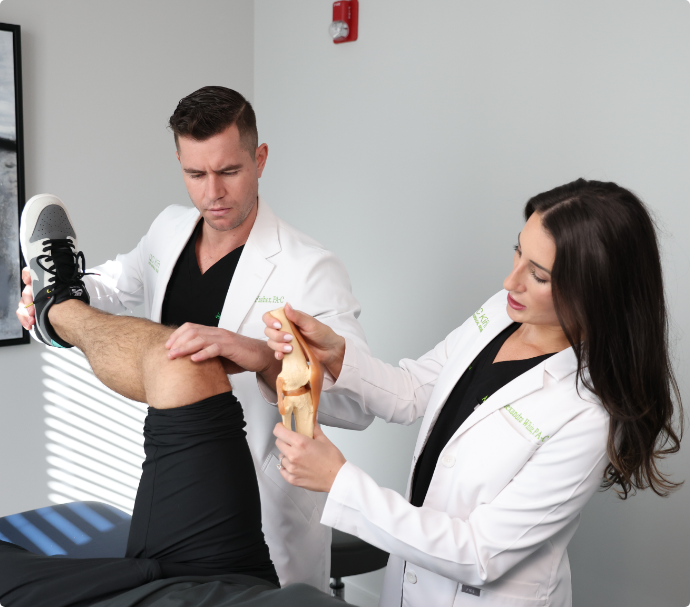Regenerative medicine has been making waves in the medical world, offering innovative, non-surgical treatments that leverage the body’s healing mechanisms. While its potential benefits are immense, myths and misconceptions often cloud the truth about this groundbreaking field.
This blog aims to debunk common regenerative medicine myths, offer clarity on its scope and safety, and help you determine whether it’s the right choice for you.
What Is Regenerative Medicine?
Regenerative medicine focuses on tapping into the body’s natural ability to repair and regenerate damaged tissues. Key modalities include platelet-rich plasma (PRP) and stem-cell therapies like BMAC. These treatments are designed to trigger the body’s healing processes, targeting the root causes of issues such as inflammation, injury, or degeneration.
For example, PRP involves using a patient’s own blood, processed to concentrate growth factors, and injecting it into the affected area to accelerate healing. Meanwhile, BMAC uses cells from the patient’s own bone marrow to promote tissue repair.
Why Regenerative Therapy Misconceptions Persist
Myths about regenerative medicine often arise from two main sources. First, marketing hype can oversell the capabilities of these treatments, leading to exaggerated claims and unrealistic expectations. Second, outdated information has muddied the waters, as some people draw conclusions based on older or poorly conducted studies.
At QC Kinetix, we use evidence-based medicine to guide our approach, ensuring that patients receive accurate information and safe treatments. Now, let’s tackle some of the most common myths about regenerative medicine.
Myth 1: Regenerative Medicine Can Cure All Ailments
While the results of regenerative medicine are impressive, it’s not a miracle cure for every condition. Its primary applications are in helping with orthopedic and soft tissue conditions such as knee pain, lower back issues, arthritis pain, and tendon injuries.
Outside orthopedics, regenerative medicine shows promise in areas like cardiology and neurology, but these treatments remain experimental. For example, therapies are being explored for heart repair after a heart attack or nerve regeneration in neurodegenerative diseases.
Myth 2: All Stem Cell Therapies Are the Same
Not all stem cell therapies are created equal. The most notable difference lies in cell sourcing. Autologous treatments use your own cells, while allogeneic therapies rely on donor cells. Autologous procedures, like those at QC Kinetix, drastically reduce the risks of rejection or adverse reactions. Allogeneic therapies are currently being researched and do not have full FDA clearance.
Additionally, how cells are processed, stored, and administered plays a significant role in their effectiveness. These processes must meet stringent regulatory standards for safety and efficacy.
Myth 3: Regenerative Treatments Are Unsafe
Some fear that new treatments come with high risks, but regenerative medicine is both safe and minimally invasive. Studies have shown that injection-based therapies, when performed by trained professionals, carry low complication rates. Side effects are typically minor, such as temporary swelling or soreness.
To further enhance the safety of regenerative medicine at our clinics, QC Kinetix uses biologics derived from a patient’s own body for our treatments, minimizing the risk of adverse reactions.
Myth 4: PRP and Stem Cell Therapies Are Identical
While both PRP and stem cell therapies are foundational to regenerative medicine, they serve different purposes. PRP works by concentrating growth factors to accelerate the healing process, ideal for minor joint injuries or soft tissue inflammation.
Stem cell therapies go a step further, using living cells to repair and regenerate damaged tissue, making them better suited for chronic or degenerative conditions.
Myth 5: Regenerative Medicine Benefits Only Athletes or the Elderly
Regenerative medicine isn’t just for pro athletes or seniors managing arthritis. Patients of all ages and lifestyles experience relief, from active professionals recovering from injuries to parents wanting to keep up with their kids.
For example, some patients can regain mobility and reduce daily pain thanks to regenerative therapy for their knee, even after years of managing osteoarthritis symptoms.
Myth 6: Results Are Immediate
One of the biggest myths about regenerative treatments: instant results. Patience is critical with regenerative therapy. While some patients notice relief soon after a procedure, the full benefits often emerge gradually over weeks to months as tissues regenerate.
The healing process involves phases, starting with inflammation and progressing through tissue growth and remodeling. Understanding this timeline helps set realistic expectations.
Benefits of Regenerative Medicine
Regenerative medicine offers numerous advantages. Unlike surgery, it’s minimally invasive, avoids long recovery times, and often doesn’t require anesthesia. Patients can typically resume their daily activities much sooner.
Additionally, these treatments focus on addressing the root cause of pain rather than simply masking symptoms, offering a longer-lasting solution.
How to Determine If You’re a Candidate
Are you considering regenerative medicine? Here are some general eligibility criteria to keep in mind:
- You experience chronic joint pain, arthritis, or soft tissue injuries.
- You’re in good overall health.
- You’ve tried conservative treatments without success.
- You want to avoid surgery or long-term medication use.
Still unsure? Schedule a consultation with QC Kinetix for an evaluation and learn what to expect from your tailored treatment plan.
FAQ that Address Some Common PRP and Stem Cell Therapy Myths
Here are answers to frequently asked questions about regenerative medicine:
Is regenerative medicine safe?
Yes, regenerative treatments have a strong safety profile, especially when using biologics from the patient’s own body. Minor side effects may include temporary swelling or soreness.
Can regenerative medicine cure all ailments?
No, regenerative medicine primarily focuses on orthopedic conditions, soft tissue injuries, and some experimental applications in other fields.
Is regenerative medicine only experimental?
No. While certain applications are experimental, treatments for joint pain, arthritis, and other conditions are well-established.
How long does it take to see results?
Patients may feel relief within weeks, but full results usually take months as tissues heal and regenerate.
Debunking the Myths and Your Next Steps
Regenerative medicine offers a safe, effective alternative for addressing chronic pain and injuries. By debunking common misconceptions, we hope you feel better informed about its capabilities and benefits.
Discover how regenerative medicine can help you get back to doing the things you love. Request a free consultation at QC Kinetix today and take the first step toward reducing pain in your life!
Medical Disclaimer:
This content is for informational purposes and not a substitute for professional medical advice. Always consult your healthcare provider before beginning any new treatment.


